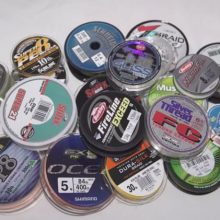This article may contain affiliate links. If you make a purchase after clicking on a link we may earn a small commission at no extra cost to you. As an Amazon Associate, I earn from qualifying purchases.
Best Line for Swimbaits

Choosing the best line for swimbaits will depend on a number of factors. There is no single line that is the best choice in every situation.
The size of swimbait, depth you are fishing, types of structures and the species of fish that you are targeting can greatly affect which line to select.
Most fishermen will tend to opt for the large style swimbaits. This means casting large lures long distances.
All that work is usually rewarded with bigger fish. I fact on waters where it is known that larger specimen bass and musky are lurking throwing swimbaits in the larger sizes is usually the go to tactic.
Best Line for Swimbaits
The best fishing line to use for swimbaits will depend on where exactly you are fishing in the water column. In shallower waters monofilament is the go to choice, whereas in deeper areas straight flourocarbon will work much better.
1. Monofilament
If you are working your swimbaits in the top 5 feet of the water column then the best option for a swimbait line will be good old fashioned monofilament.
Mono has better floating properties than flourocarbon as it is less dense.
Mono will help to keep the swimbait up a little as you are fishing over shallows and weed-beds. It also has a lot more stretch than the other two lines so when setting large treble hooks you have less of a chance of ripping a lip.
Most swimbait reels will have their line capacity quoted in lbs for monofilament.
2. Flourocarbon
Flouro can be used when you intend on working a swimbait into deeper waters. Because it is more dense than mono it can help to get your lure a little bit deeper.
It will not stretch as much as mono and as a result you may not get as good of a side to side action from the lures especially if they big glide baits.
I have found that the extra stretch that mono gives you acts as somewhat of a spring, and if you have selected the correct action on your swimbait rod the you can work them back and forth to great affect.
3. Braided Fishing Line
There are two scenario’s where I would use braid for swimbaits:
- Targeting large species like pike or musky
- Working weedless swimbaits over thick cover
Note – braid has a higher risk of snapping especially when using really heavy lures. As you retrieve the top layer of braid can and does get bedded down into the previous layers that are already on the spool.
The consequences of this is that your cast may stop dead in mid flight if it is bedded in too tight, this can result in the line snapping and you losing your big expensive swimbait.
The advantage that braid gives you is when you are using a weedless swimbait.
Due to it’s smaller diameter braided fishing line will slice through weeds much easier than mono of flourocarbon.
So when working large weed-beds and lilies I’d opt for braid as the go to line for larger swimbaits.
Generally you’ll want to pair the braid main line with a flourocarbon leader. If you happen to snap the line chances are it will be on the leader.
When fishing for larger pike or musky then you really should use a wire leader to the lure.
